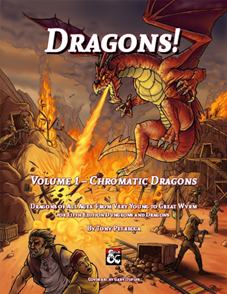 The original release of Dungeons & Dragons presented dragons at six various ages throughout their life – at Very Young, Young, Sub-Adult, Adult, Old and Very Old. At the time, six-sided dice were used for hit points. While for an ogre you’d pick up 4d6 and take the total, Dragons assumed that each dice had the same result. Thus, very young dragons had 1 hit point per die, while very old dragons had 6 hit points per die.
The original release of Dungeons & Dragons presented dragons at six various ages throughout their life – at Very Young, Young, Sub-Adult, Adult, Old and Very Old. At the time, six-sided dice were used for hit points. While for an ogre you’d pick up 4d6 and take the total, Dragons assumed that each dice had the same result. Thus, very young dragons had 1 hit point per die, while very old dragons had 6 hit points per die.
When AD&D came out a few years later, monster hit dice went to d8s, and dragons gained two more age categories: Young Adult and Ancient. In 1987, the Forgotten Realms added two more categories, Venerable and Great Wyrm, for nine and ten hit points per dice respectively.
One of the oddities in how the dragons were presented was that their damage dice didn’t change as they gained levels. So, a Very Young Red Dragon did as much damage as a Great Wyrm Red Dragon: 1-8/1-8/3-30 in AD&D. Observant DMs changed the dice codes depending on their ages. Killer DMs didn’t.
With the development of 2nd Edition, we got to 12 ages of dragons (with Hatchling and Juvenile being the new ones). Combat damage now varied by level – but only by a bonus that increased from +1 to +12. A hatchling red dragon dealt 2-11/2-11/4-31 damage in melee! It wasn’t until 3E that damage codes became more varied (and less lethal). And 4E was the first to give full statblocks for dragon ages, rather than requiring you to calculate their statistics yourself.
4E’s method of providing full statistics for dragons has been followed in 5E. This is fine – it makes things much easier to use at the table. The disadvantage is that there isn’t room for every conceivable age. Instead, we get four ages for each type of dragon: Wyrmling, Young, Adult and Great Wyrm. In the case of a Red Dragon, that gives Challenge Ratings of 4, 10, 17 and 24. What do you do if you want to use a Red Dragon at level 6?
 Tony Petrecca’s answer is to write a set of intermediate stat blocks for each Dragon. The result, Dragons!, can be found on the DMs Guild in two volumes: Chromatic Dragons and Metallic Dragons.
Tony Petrecca’s answer is to write a set of intermediate stat blocks for each Dragon. The result, Dragons!, can be found on the DMs Guild in two volumes: Chromatic Dragons and Metallic Dragons.
For each dragon, he provides six additional ages. In the case of the Red Dragon, the categories and Challenge Ratings are as follows: Very Young (CR 7), Juvenile (CR 12), Young Adult (CR 14), Old (CR 20), Wyrm (CR 27), and Great Wyrm (CR 30).
The statistics don’t make changes to the capabilities of dragons, instead just providing interpolations of their statistics. Great Wyrms don’t suddenly get new tricks, but their existing tricks are far deadlier. I’m not sure how many players actually need to face a CR 30 dragon, but the DM has the option of using one if he or she wishes!
The layout of the product is good, and it’s attractively presented. There are a few glitches here and there (a missing space, a misaligned divider), but they’re minor at best.
If you want more flexibility in how you use dragons, Dragons! is an inexpensive option to save yourself the time of messing around with numbers and trying to calculate Challenge Ratings. Recommended.
